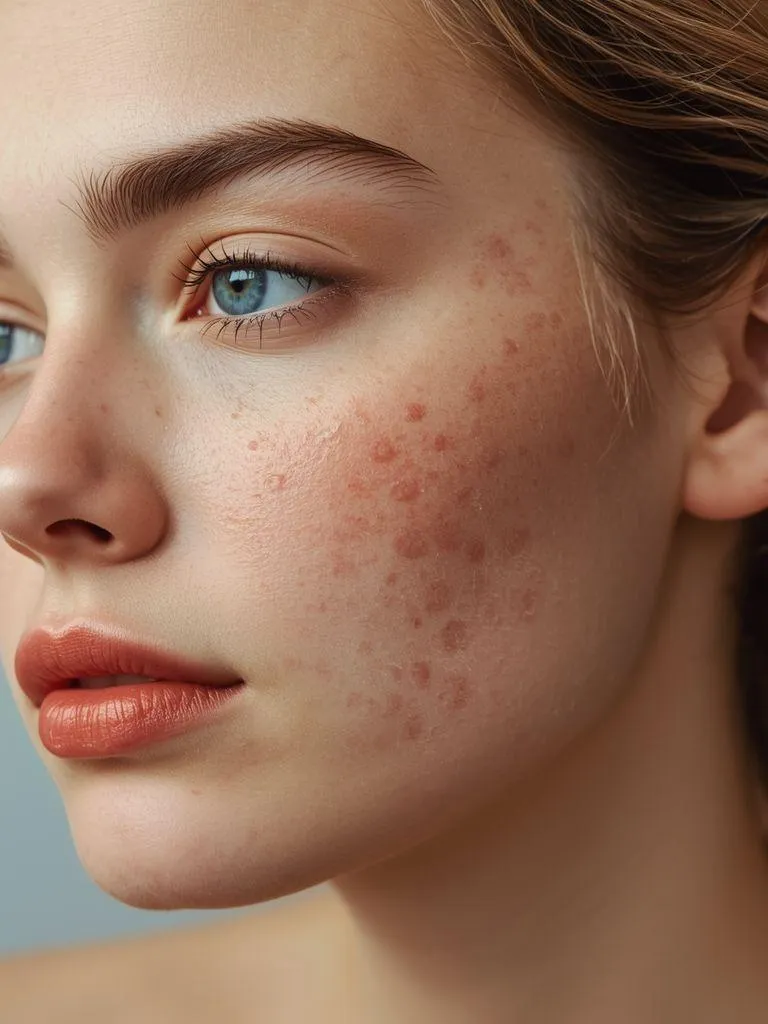- Felix Weber
- October 23, 2025
- 8min.
- Report
Nutrition and Acne – a Current Literature Review
Despite the passage of time, numerous popular myths about acne continue to circulate, including those related to nutrition. The role of diet can be considered significant, yet it is unclear how effective a particular dietary approach can be in alleviating the symptoms of this condition. The frequency of acne in Western countries cannot be easily explained solely by genetic inheritance, and lifestyle likely plays a significant role as well. What can be considered a genuine threat to skin health, and what as mythical folklore? In this article, we will present the latest scientific data on the impact of diet on skin condition.
Table of Contents
1. Chronic skin state
The pathogenesis of this complex skin condition involves increased sebum secretion and excessive keratin accumulation. As suggested by R. N. Smith and colleagues in their study, the severity of acne may be related to the levels of androgens such as testosterone and dehydroepiandrosterone (DHEAS). These changes can also be exacerbated by insulin and insulin-like growth factors (IGF-1). These changes can persist beyond the adolescent period and even appear for the first time later in life. Adult acne is a condition that occurs after the age of 25 (or earlier) and affects women more often than men. It remains unclear whether a specific diet can support acne management. In the study by M. Markovic and colleagues, it was found that adolescents in Bangladesh reported emotional stress, consumption of sweets, fatty foods, and lack of sleep as factors that exacerbate acne.2. Simple sugars and acne
In a study conducted by R.N. Smith and colleagues, adolescent boys with acne (15-25 years old) who were not undergoing pharmacological treatment were recruited. Among them, 23 participants followed a low-GI diet (LGI), while 20 adhered to a normal GI diet. After a 12-week study period, the results were evaluated by experts. The study revealed that participants on the LGI diet exhibited a significant reduction in insulin resistance and improved insulin sensitivity compared to the control group. This may be attributed to the lower glycemic index of the LGI diet, as well as the observed weight loss and reduction in body fat percentage. The decrease in insulin resistance may be linked to a decrease in androgen hormone levels, which can have a positive impact on skin health.3. Chocolate and skin changes
The IG of chocolate varies depending on its sugar and milk content. Milk chocolate, as a product with high IG, may potentially have a negative impact on skin condition, while dark chocolate with high cocoa content does not necessarily. However, a study by S. Vongraviopap and P. Asawanondy may be disappointing for chocolate enthusiasts. This study involved 25 men aged 18-30 who consumed 25 grams of dark chocolate with 99% cocoa for 4 weeks. Unfortunately, an increase in skin changes was observed in the participants. In a study by T. S. S. Suppiah and colleagues, it was found that acne patients consume milk and chocolate more frequently than individuals without acne. These results contradict studies published in the 1960s and 1970s, which found no association between chocolate consumption and the onset of acne.4. Dairy products and their influence on acne
It has been suggested that milk and dairy products may have a negative impact on acne due to a potential effect of increasing IGF-1 levels. One of the most recent studies on the relationship between the consumption of dairy products and acne was published in 2019 in the journal Clinical, Cosmetic and Investigational Dermatology. This was a retrospective study, which evaluated the previous dietary habits of acne patients and healthy individuals. A total of 279 participants aged 10-24 years participated in the study. It was found that acne patients consumed fat-free milk, 3 portions or more per day, cream, and eggs more frequently. No differences were observed in the consumption of yogurt and cheese. These results confirm the majority of the results of previous studies, which the American Academy of Dermatology refers to in its guidelines for the treatment of acne from 2016.5. Nutrition and skin aging
The involvement of the skin in UV radiation results in acceleration of the aging process. However, a diet rich in carotenoids can provide protective effects in the context of sun damage. This was demonstrated in a study (W. Stahl et al., 2001) in which daily consumption of 40 g of lycopene-rich tomato paste (carotenoid-rich compound) over a period of 10 weeks contributed to a decrease in the sunburn reaction. In a similar study from 2000, W. Stahl and colleagues showed similar results and found that the effects of carotene supplementation were enhanced with a single intake of vitamin E. To ensure an adequate intake of carotenoids in the diet, the following foods should be included: carrots, lettuce, spinach, beets, pumpkin, tomatoes, red bell peppers, oranges, grapes, peaches, plums, apricots. Vitamin E is mainly found in plant oils, sunflower seeds, pumpkin seeds, hazelnuts, almonds. However, it is important to note that excessive sun exposure increases the risk of skin diseases and is not recommended. People suffering from acne can be recommended a diet with a low glycemic index. It is not recommended to exclude dairy products without justification due to their high nutritional value. As the consumption of dairy products does not lead to skin problems in all individuals, observation is the basis. Temporary restriction or elimination of certain foods from the diet allows for the assessment of the effects. The inappropriate application of elimination diets often leads to more harm than good.
Latest Nutrition Plans

Express Shape – 1600 kcal Protein Nutrition Plan – 3 Weeks to a Healthier You

Accelerated Transformation - a protein-rich plan with 1600 calories for 14 days

Revolutionize Your Body - A 7-Day Fast Protein Plan for Extraordinary Weight Loss

Ultra-Low Carb Adventure - A 4-Week, 1600 kcal Plan for a Lighter, Healthier You

Energize Your Life - A 4-Week High-Protein Slimming Plan with 1500 kcal for Energy and Weight Reduction

Sven's Plan - A 4-Week, 1500 kcal Slimming Program for Healthy Energy and Transformation

Express diet 1300 kcal - quick reduction in 4 weeks according to Sven

Step Up Your Life - A 4-Week, 1400 kcal High-Protein Slimming Plan

Fit Body - A 4-Week, 1400 kcal Healthy Slimming Diet for Optimal Results

Slim Plan 28 - A 28-Day, 2000 kcal Weight Loss Plan for Optimal Results

Dream Shape - A 4-Week, 1800 kcal Weight Loss Plan for Lasting Change.

Protein Power 4 - A 4-Week, 2200 kcal High-Protein Diet for Energy and Optimal Weight Loss

